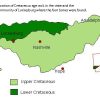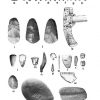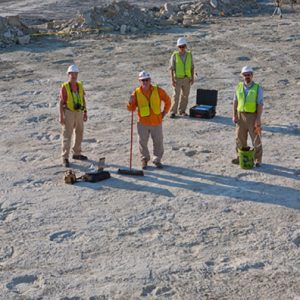calsfoundation@cals.org
Nashville Sauropod Trackway
The Nashville sauropod trackway, which may be the largest dinosaur trackway in the world, was located near Nashville (Howard County). The most unusual thing about the Nashville trackway is its size, but it also represented, for over twenty-five years, the only evidence of sauropods in Arkansas other than bone fragments found nearby. This discovery has greatly informed the scientific study of sauropods and other dinosaur trackways.
A trackway is a path of preserved footprints left by dinosaurs. There are between 5,000 and 10,000 assorted tracks on the Nashville trackway, most of which have been identified as having been made by sauropods. Some species of sauropods are the diplodocus and the titansaur. Sauropods had long necks and long tails and walked on all fours; they were all herbivores. Fossils and footprints from some species of sauropod have been found on every continent except Antarctica.
The footprints in the Nashville trackway range from twelve to twenty-four inches across. The back prints are U-shaped with a slight depression by the front edge. The front prints are shaped similarly but are more round and point outward. It appears from the tracks that the dinosaurs’ toes on the back feet were flexible, which helped them get through mud or change their pace. At least ten dinosaurs left the footprints. They were all full-grown, and their average strides were 2.5 meters. The depth of the tracks varies.
Since it appears that the footprints were made over a period of time, it is likely that they are from a migration path, despite the fact that separate paths of footprints made at different times go in different directions and even cross each other. Some of the earlier and poorly preserved tracks have well-preserved tracks over them. Many other sauropod trackways, such as one found near Oxford, England, and another five miles from Glen Rose, Texas, seem to be migration paths as well.
Scientists believe that the footprints may have been made as long as 100 million years ago in the early Cretaceous period. The tracks were made in a mudstone layer, which was also rich in limestone. The tracks were covered in soft clay and sediments until they were discovered in 1983 in a quarry at the Briar Plant, a gypsum mining plant owned by the Weyerhaeuser Company.
At that time, Jeffery G. Pittman was doing research on exposed rocks in the quarry for his master’s degree at Southern Methodist University (SMU). He had to drive his truck over the quarry floor every day, but the ground was uneven with what he thought were potholes. That fall, a former professor, David Gillette, took him to see dinosaur trackways in Colorado and New Mexico, which looked very much like the potholes in the quarry near Nashville. After taking another look at the Nashville footprints, Pittman called Gillette, who at that time was curator of vertebrate paleontology in the New Mexico Museum of Natural History. Gillette came to Nashville in December and confirmed that the potholes were a sauropod trackway.
However, the footprints had already started to break apart. The limestone that still covered many of the tracks was very brittle, and each rainstorm weathered the exposed tracks more. Some scientists believed that it was already too late to preserve any of the footprints. On top of that, that area of the quarry was scheduled to be mined for gypsum in January 1984, which would not provide enough time to study the prints. In a compromise with scientists, Weyerhauser moved operations to another part of the quarry for six weeks during January and early February so that work could be done on the trackway. It was not enough time for a full excavation but did allow researchers enough time to make molds, take photographs and make sketches, and preserve some prints. Supplies for the mold were donated. Dow Corning donated 150 pounds of silicone rubber, and an SMU alumnus in Dallas donated a large amount of fiberglass, which was used as a backing.
A team was assembled from scientists, professionals, students, and volunteers to make a study of the trackway. One task they found especially difficult was cleaning mud and debris away from the footprints without damaging them. They tried using high-pressure air and water jets, but the most effective method was shovels and brooms. They made molds of the prints while also hoping to preserve portions of the trackway.
A 200-foot section of the best-preserved track was cleaned and mapped. Eighty feet of that was cast in silicone rubber with the fiberglass backing. This mold was cut into sections and shipped to New Mexico, where duplicates were made. These copies were sent to museums and other institutions, several of which were in Arkansas, including the University of Arkansas (UA) in Fayetteville (Washington County), the Mid-America Science Museum in Hot Springs (Garland County), the Museum of Discovery in Little Rock (Pulaski County), and Lyon College in Batesville (Independence County). In April 1984, a drive was organized to raise money for a display on the lawn of the new Howard County Courthouse in Nashville. However, the fiberglass was weathering, and so the molds had to be put in storage.
Reproductions of the molds are still at several of the museums in Arkansas. Even though only a few individual tracks were removed and preserved, and the original trackway is gone, the Nashville sauropod trackway was an important discovery. In 2011, a similar dinosaur trackway, which included sauropod tracks, was discovered in southwestern Arkansas.
For additional information:
“Dinosaur Trackway Probably Can’t be Preserved, Official Says.” Arkansas Gazette. March 23, 1984, p. 7A.
“Drive Benefits to Raise Money for County Dinosaur Walk.” Arkansas Gazette. April 3, 1984, p. 8B.
Graves, Louie. “Potholes are Tracks of Dinosaurs.” Arkansas Gazette. November 30, 1983, pp. 1B–2B.
Pittman, Jeffery. “Dinosaur Tracks: Rare Find for Arkansas.” Arkansas Gazette. December 25, 1983, p. 11B.
Pittman, Jeffery G., and David D. Gillette. “The Briar Site: A New Sauropod Tracksite in Lower Cretaceous Beds of Arkansas.” In Dinosaur Tracks and Traces, edited by David D. Gillette and Martin G. Lockley. Cambridge: Cambridge University Press, 1989.
Anastasia Teske
North Little Rock, Arkansas


 Dinosaur Tracks
Dinosaur Tracks 




Comments
No comments on this entry yet.